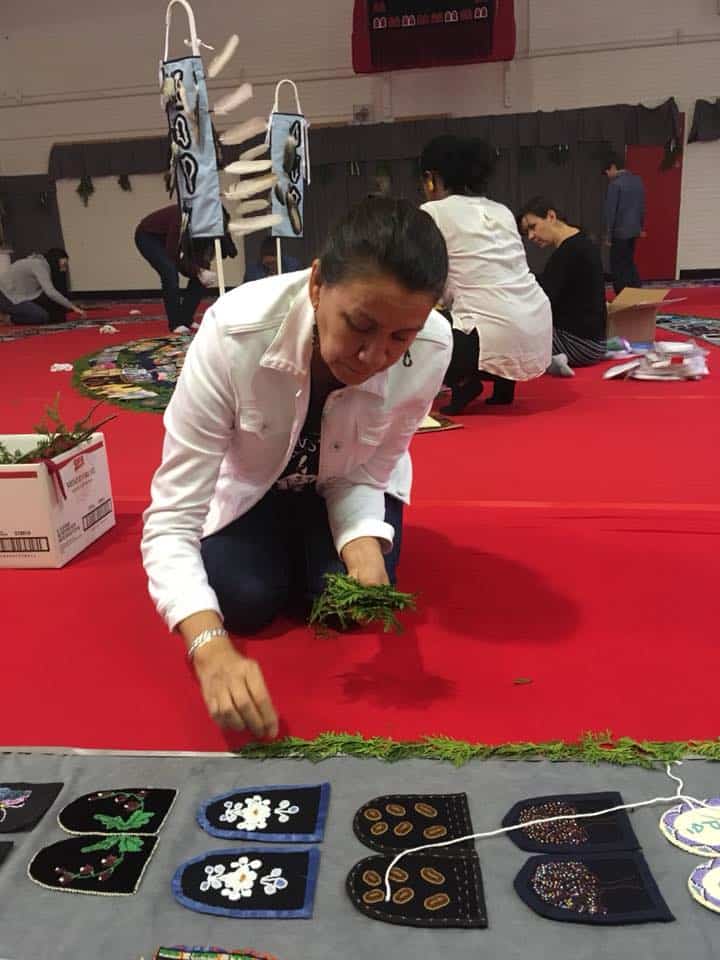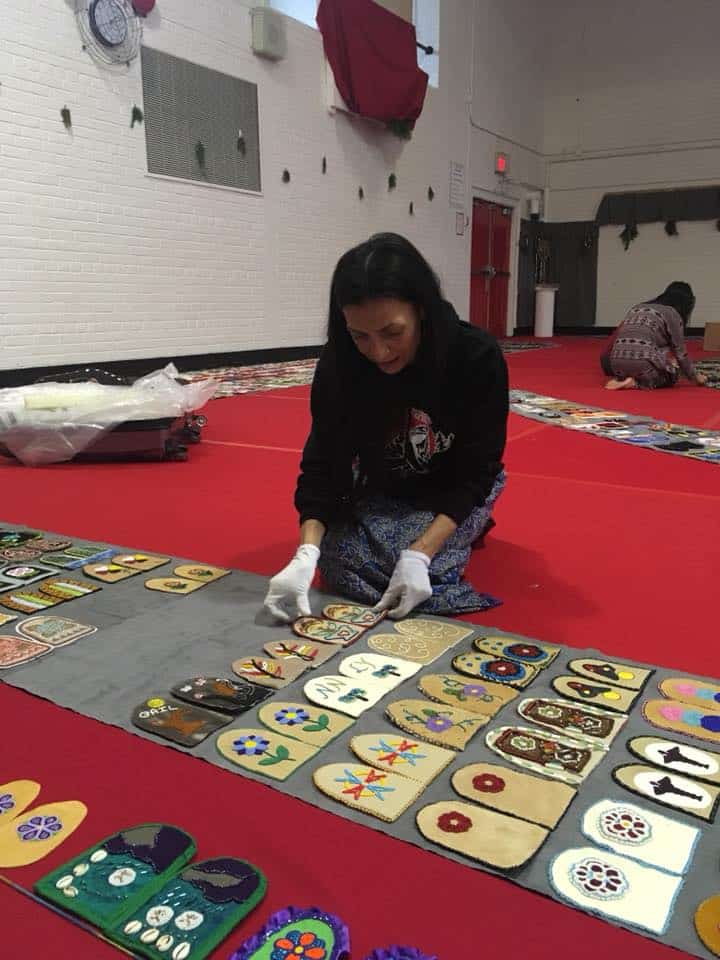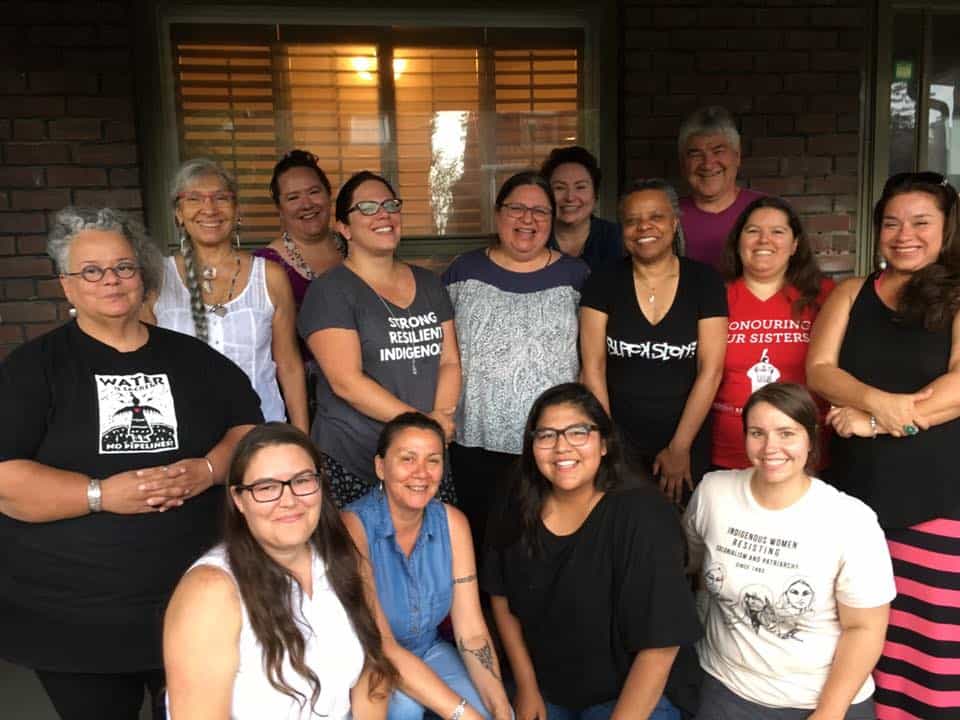
Q&A with: Walking With Our Sisters Toronto
Walking With Our Sisters (WWOS) is much more than an art exhibit that raises awareness about missing and murdered Indigenous women, girls, trans and two-spirit people. It is also a ceremony centered on supporting families and communities who have experienced loss. WWOS is a commemorative art installation of approximately 2000 pairs of moccasin vamps (the top part of the shoe that is typically decorated with beadwork), created by over 1300 artists. Each pair of unfinished moccasins represents the unfinished life of a loved one. The commemoration has been traveling to communities across Canada and the US since 2013, and will conclude in 2019. WWOS is organized by local collectives of volunteers in each host community as it travels, and is supported and coordinated by a national collective. Inspirit was privileged to support the Toronto installation of WWOS, which was open to the public in October. I spoke with Krysta Williams and Rebecca Beaulne-Stuebing, co-lead organizers from WWOS Toronto, about their experiences collaborating on the commemorative installation.
Krysta Williams is a Lenape woman from the Turtle clan and the Moravian of the Thames First Nation and she is currently the Advocacy and Outreach Co-Coordinator for Native Youth Sexual Health Network.
Rebecca Beaulne-Stuebing is a Métis Anishnaabe woman from the Eagle clan, currently working on a PhD in social justice education at OISE.

Q: How did Walking With Our Sisters (WWOS) come about?
Rebecca: The initiative itself started in 2012. It came through spirit and vision around what would take place. Christi Belcourt received a vision which then became this commemoration, the vision was about creating space to honour the lives of people in our communities who have gone missing or who have been murdered. With guidance from the lead ceremonial Elder for WWOS, Maria Campbell, a call was put out on Facebook asking for people to submit moccasin vamps. Christi received over 1200 pairs, and in 2013 Walking with our Sisters began its journey traveling to communities. It will travel for 7 years in total, hosted locally in each community in accordance with ceremony protocols of that territory. It is a profound community process and experience of collaboratively creating ceremony in response to our real and urgent needs. Local organizing committees often prepare for years to host the commemoration. Communities are supported by the WWOS national collective in their preparation.
Krysta: Often the leadership around Walking With Our Sisters is focused on Christi Belcourt, so it is important to emphasize how over time, the national collective has evolved and grown in the processes of helping organize these ceremonies. The collective has over 20 or 30 artists who are spread throughout Turtle Island. This is also part of how we talk about Indigenous art and how we talk about ceremony, which is that nobody can own it. It’s not about ownership at all, but about collective responsibility and caring for those responsibilities. And each community needs its own collective, its own organizing committee and committed individuals who can see the initiative through because it can’t just be somebody coming in and saying, “This is how you’re going to do it.” WWOS is not just an exhibit; its primary aim is to help families who have experienced loss. We often try and remind people and use the language of a commemorative art installation or ceremony. In the context of missing and murdered Indigenous women, girls and two-spirit people, there isn’t a whole lot of space to grieve. There’s a lot of media attention, there is a lot of assumptions made, there’s a lot of police intervention or lack of intervention, but there isn’t space for families or communities who are in that public sphere to grieve or to process the trauma in a safe space without being surveilled or watched. So for me, one of the important parts of this initiative is that family members are the only people that can add vamps as the exhibit travels. So the bundle grows, and that privilege is only reserved for family members. Having people’s names, photos, death and missing dates rehumanizes the numbers, the media stories, the statistics that we hear. The fact that WWOS specifically dedicates time and space for that is actually really powerful.
R: It depends on where this commemoration is being hosted, what that involvement looks like for families–and when we say “families” we mean people who are directly affected by this loss. So it’s not always blood relatives, but also chosen family and community and friends. Every community looks different in that way and sometimes the organizers who bring this together are family members themselves. They’re making this happen while also being directly affected. In my involvement with WWOS, I am learning about what it means to hold space for each other in community, or as a network of communities, in this experience of grief that ebbs and flows but never really stops. How to support and care for one another in immediate and urgent ways, with also a longer view that can transform how we live together. Doing this work collectively, decentering egos and politics, is the approach necessary for WWOS and it allows for a different kind of space that is loving, that provides supports communities decide they want and need. There’s a prioritization of family members and their needs as opposed to what other people might want in creating this memorial. To be specific, in the Toronto context the organizing was really complex and we were often faced with difficult decisions, for example, coming up against what institutions or organizations might want to see happen. Sometimes it involved making those hard decisions to tell people in power that what they want is not going to happen because our priorities are different. The purpose of [WWOS] is actually not to have as many people as possible walk through the doors, or to be open to the public for as long as possible. What matters more is that with the time that we had there, and with the things that we did, we were as supportive of family members as possible every step of the way. That we could take care of each other all the way through—that’s a very different approach than what might seem fundable or what might receive the most media attention. Some people wanted it to be seen as the biggest thing ever, because Toronto is the biggest city Walking With Our Sisters will travel to and it is this huge opportunity for raising awareness. But I think it’s actually more about what’s quietly happening and the impact that this has had on people really intimately. It can stay private; it doesn’t always have to be shared.

Q: How did WWOS come to Toronto?
K: Community meetings were taking place as far back as 2014, but the main challenge was finding an appropriate space to host Walking With Our Sisters. We do not have enough access when it comes to Indigenous-controlled spaces—spaces that aren’t surveilled or policed especially around ceremony, where we have access to the outside and aren’t just cooped up indoors. There still isn’t enough space for us to hold ceremony especially in the city. So those were some of the initial conversations, and it is still an issue in Toronto. We also had to figure out who had the capacity—who had the time to dedicate to the ceremony, when we’re all really struggling to get by in our communities. We’re very overworked, especially for folks who are culturally or traditionally inclined.
R: In May 2014 we hosted Walking With Our Sisters in Sault Ste. Marie. I was one of the organizers of that installation and have since been involved with WWOS. In 2015 I moved to Toronto for school, and I became involved in the Toronto organizing about a year ago when meetings started up again once a potential venue became more than just potential. That was my involvement in the Toronto process.

Q: What have you noticed that’s new about the installation in Toronto?
R: Every time Walking With Our Sisters takes place in a community, there’s much that’s new and different specific to that place. Personally what I noticed about the Toronto organizing process, and that is reflected by the leadership on this initiative and from other people from our planning collective team, is the prioritizing of two-spirit leadership in our organizing. The Toronto two-spirit community is amazing and people have been working for so long to make community and ceremony happen here. We were able to create this ceremony in Toronto in a way that learned from that leadership that has been so vital in Toronto, but has been unrecognized and definitely not adequately supported. It’s not that we really figured anything out but we were asking questions. The bringing together of so many different people to have those conversations—that was new to me. And we did it completely outside of an organization. That was another reflection from a lot of Indigenous people in this process who may be from Toronto or who have lived in Toronto for a really long time: it’s very rare for initiatives to happen in the Indigenous community that are not housed in or programmed by an organization. There are real reasons for this, we need jobs to get by. We don’t have the capacity, living in Toronto, to do community organizing as volunteers at this scale. But this organizing really shapes a community and defines the kind of work that’s even possible.
Krysta and I being co-lead organizers doesn’t mean we led the whole initiative, to be clear. We just took responsibility for logistics, information-sharing and generally holding it down. It took so many people to make this happen. The planning committee was over 40 people, and while open to the public there were at least 150 volunteers. There were years of planning meetings in Toronto, which really intensified in the six months leading up to the commemoration. We were open for ten days with an additional week to install, and a week to de-install. It is just so much work and so much of it is not visible. I think this is incredible, that we were able to do what we did, for the time that we did, with all the other commitments that we all have. Of course not everybody came out, and of course not everyone felt amazing about everything. We were still able to hustle and fundraise—we fundraised twice the amount that we were aiming for! There’s something about this momentum of people coming together, caring so much, and then finding something in the process of coming together, realizing that we actually need these spaces that are caring, tender, loving and centre the real needs of people in our communities.
K: The only thing I would add is regarding the international cooperation. I say that tongue-in-cheek because people assume that means state-based entities but I’m literally talking about Indigenous nations here in Toronto having to come together on a shared territory and figure out ceremonial protocol and make a decision together. We can’t do all the things, so what are the things that are especially important? And not that we did it perfectly, but those decisions were really challenging but they got made and it took a lot of iterations, a lot of sitting around saying, “OK, let’s talk about it again. Do people have new ideas? Did people have a dream?” Maybe somebody new has joined and they’ve got something else to add. To do that well was really challenging. A lot of communities that are housing just one or two nations, it’s a little bit more clear how they do things, but specifically for urban spaces like Toronto, what was a really important value very early on is that people wanted to make sure that Indigenous people who call this place home now can feel that their ancestors, their traditions and their ways of being can be held in this space. I think that was something really different.

Q: : How does the issue of missing and murdered Indigenous women, girls, trans and two-spirit peoples relate to broader conversations, like the International Day for the Elimination of Violence Against Women?
R: Big question there. First and foremost, it is distinct from larger conversations about violence against women because larger conversations are not taking into consideration colonial violence, displacement from land, and the continual attempted elimination of Indigenous peoples through legislation, through incarceration and so on. If in these conversations about violence against women we can’t also talk about land and question the very existence of Canada as a colonial state, then we aren’t having the same conversation. That is not to mention the erasure of two-spirit and trans people that is totally unacceptable, but continues to happen when violence against women is talked about.
K: The other important distinction is that, when we’re talking about international frameworks and Indigenous rights—we’re already international. If we’re talking about these nation-to-nation relationships, that means Indigenous nations as well. When the term “international” is used in the context of international human rights, it automatically leaves out Indigenous nations and our sovereignty in specific ways that are historic. We are basically barred from those spaces and don’t have equal standing. So how can we talk about ending violence against women in our communities when we don’t have the same access to platforms and we aren’t taken seriously. I imagine it’s very en vogue to talk about Indigenous issues. When we are talking about the International Day to End Violence Against Women, it’s focused on gender, but Indigenous experiences of gender are intimately tied to colonialism and land, and those conversations don’t happen; they’re very siloed. So we’re caught in this weird in-between place that doesn’t make space to articulate what colonial violence looks like, what our resistance looks like and what our solutions look like. The international stage can become very narrow-minded in terms of what we’re allowed to say.
All photos are generously provided by Walking With Our Sisters Toronto.
Don’t forget to check out our past Q&As with Akio Maroon and Ilyas Gora.